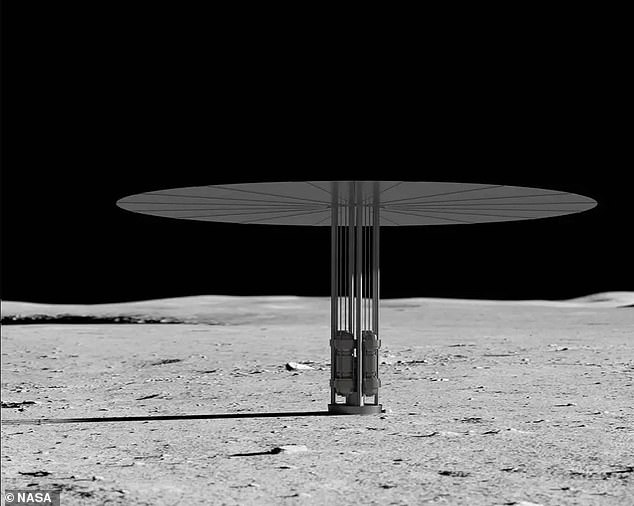New Space Race: US, China, and Russia Compete to Build Moon Nuclear Reactor

The New Space Race: A Lunar Power Struggle
The Cold War era was marked by intense rivalry between the United States and the Soviet Union, with both nations striving to prove their technological superiority. One of the most iconic achievements of this period was the race to land a human on the moon, which the U.S. ultimately won in 1969. However, the competition has not ended—it has simply evolved into a new and even more complex space race, this time focused on the moon.
This week, it was revealed that Sean Duffy, the head of NASA, is planning to install an American nuclear reactor on the moon before 2030. This initiative aims to establish a "keep-out zone" on the lunar surface, which would protect the site for a future American moon base under the Artemis Programme. The move is seen as a strategic step to secure a foothold on the moon and ensure long-term presence.
While the U.S. is making significant strides, it is not alone in its ambitions. In May, China and Russia signed a memorandum of cooperation to build their own nuclear reactor on the moon, with a target completion date of 2036. This development has sparked a head-to-head race among the three superpowers to be the first to establish a lasting lunar presence.
Strategic Shifts and Funding Priorities
Despite recent budget cuts to scientific missions, NASA has allocated over $7 billion for lunar exploration, signaling a major shift in focus towards human space exploration. The Artemis programme, once at risk of being scaled back, is now set to return humans to the moon by 2027. This rapid pivot highlights the growing importance of the moon in global space strategy.
In his directive, Mr. Duffy emphasized the need for NASA to "move quickly" in establishing a nuclear reactor on the moon to support a future lunar economy. He has tasked NASA with placing a reactor capable of producing at least 100 kilowatts on the moon by the end of the decade. This level of energy could power approximately 80 average American households and serve as the backbone for a permanent lunar base.
NASA had previously planned to deploy a 40-kilowatt reactor in a similar timeframe, but it remains unclear if the same designs will be used. Mr. Duffy has given NASA 30 days to appoint an official to oversee the operation and 60 days to issue a request for proposals from commercial companies for the project.
Why Nuclear Power Is Key
Nuclear power is considered essential for sustained lunar operations due to the moon's extreme conditions. At the South Pole, where NASA plans to establish its operations, the sun never rises high above the horizon, and some craters are in permanent darkness. This makes solar power and batteries impractical for long-term survival.
The sudden push towards lunar exploration is likely driven by increasing competition from other superpowers. Mr. Duffy warned that the first country to establish a lunar presence could potentially declare a "keep-out zone," which would hinder the U.S. from setting up its planned Artemis presence if it arrives later.
International Collaboration and Competition
Russia and China’s plans to build a nuclear reactor on the moon have been announced, with the goal of powering the International Lunar Research Station (ILRS), scheduled for completion by 2036. This station will involve 17 countries, including Egypt, Pakistan, Venezuela, Thailand, and South Africa. The groundwork for this project will be laid by China's upcoming Chang'e-8 mission, which marks the nation's first attempt at a human moon landing.
Dr. Mark Hilborne, a security studies expert from King's College London, highlighted the strategic value of the moon as a low-gravity staging base for future space developments. He noted that lunar materials, mined in situ, could be used to build elements that further lunar exploration, significantly reducing costs compared to sending everything from Earth.
Legal and Ethical Considerations
The Outer Space Treaty, signed in 1967, prohibits any nation from claiming sovereignty over celestial bodies like the moon. However, the U.S. has recently adopted a more assertive approach through the Artemis Accords, which allow states to implement "safety zones"—exclusive areas that others cannot enter without permission. While the U.S. claims these boundaries will end when the relevant operation ceases, they function similarly to territorial borders for permanent colonies.
Dr. Jill Stuart, an expert on space law from the London School of Economics, pointed out that while safety zones may seem fair, they create a "first mover advantage" for those who can establish bases first. This raises concerns about potential conflicts, especially since China and Russia have not signed the Artemis Accords and are not legally bound to respect U.S. "keep-out zones."
The Future of Lunar Exploration
As the race to the moon intensifies, the potential for conflict grows. Dr. Fabio Tronchetti, a space law expert from Northumbria University, warned that the U.S. is attempting to set the rules of the game unilaterally, which could lead to tensions with other nations. The outcome of this lunar power struggle remains uncertain, but it is clear that the moon is becoming a focal point for international competition and collaboration.
With the potential for conflict extending beyond Earth, the next chapter of space exploration may soon unfold on the lunar surface.

Comments
Post a Comment